Abstract
1. The effects of the muscle-depolarizing drug succinylcholine (SCh) on the stretch responses of jaw-closer muscle spindle afferents were studied in the anaesthetized cat. Using ramp and hold stretches repeated every 6 s the basic measurements made were: initial frequency (IF), peak frequency (PF) and static index (SI), the frequency 0.5 s after the end of the ramp of stretch. Derived from these were: dynamic difference (DD) = PF-IF, dynamic index (DI) = PF-SI and static difference (SD) = SI-IF. Increases in these measures caused by a single I.V. dose of SCh (200 micrograms kg-1) are symbolized by the prefix delta. 2. In a population of 234 units, delta DD and delta IF were each distributed bimodally, but were uncorrelated, thus defining four subgroups. 3. delta DD was argued to be an index of the effect of bag1 intrafusal fibre contraction and delta IF to be an index of the effect of bag2 fibre contraction. On this basis it is proposed that units can be divided into four groups according to the predominant influences of the bag1, bag2 and chain fibres as b1c (6.8%), b1b2c (22.2%), b2c (54.3%) or c (16.7%). 4. Testing with sine wave stretches at 1 Hz showed that changes in mean frequency and amplitude of response caused by SCh correlated with delta IF and delta DD respectively, but separated groups of units much less effectively than did ramp and hold testing. 5. Evidence is presented to indicate that the control value of DD in passive spindles does not relate to the potential strength of bag1 fibre effects in fully activated spindles. The bag1 fibre appears to contribute little to responses of spindle afferents in the passive state. DD is superior to DI as a measure of bag1 effects. 6. Conduction velocity was unimodally distributed in masseter spindle afferents and was not correlated with delta DD or delta IF and was therefore of no value in classifying them. 7. Neither the threshold of afferents to quick transient stretch nor the coefficient of variation of interspike intervals provided any significant additional help in classification. 8. The unexpectedly high proportion of units of b2c type is thought to include primaries lacking appreciable bag1 fibre contacts and secondaries with more or less substantial bag2 contracts.
Full text
PDF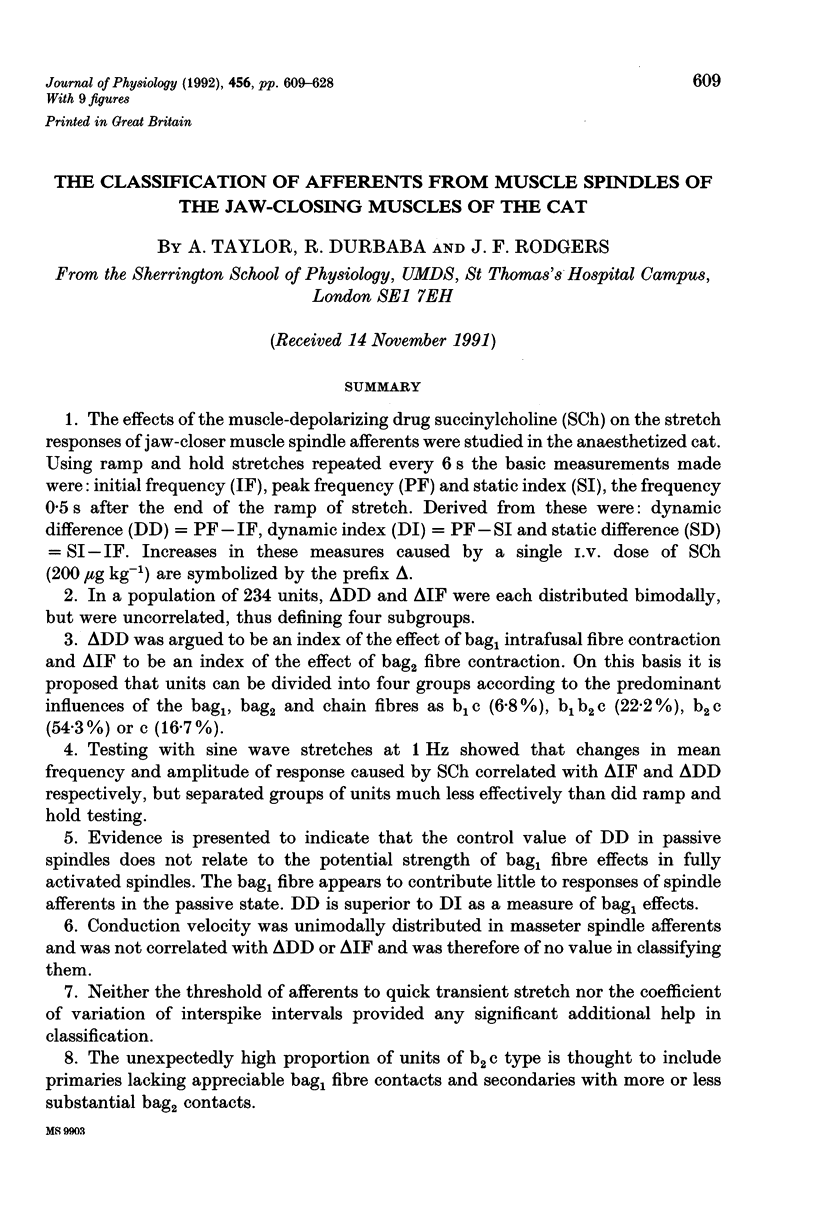
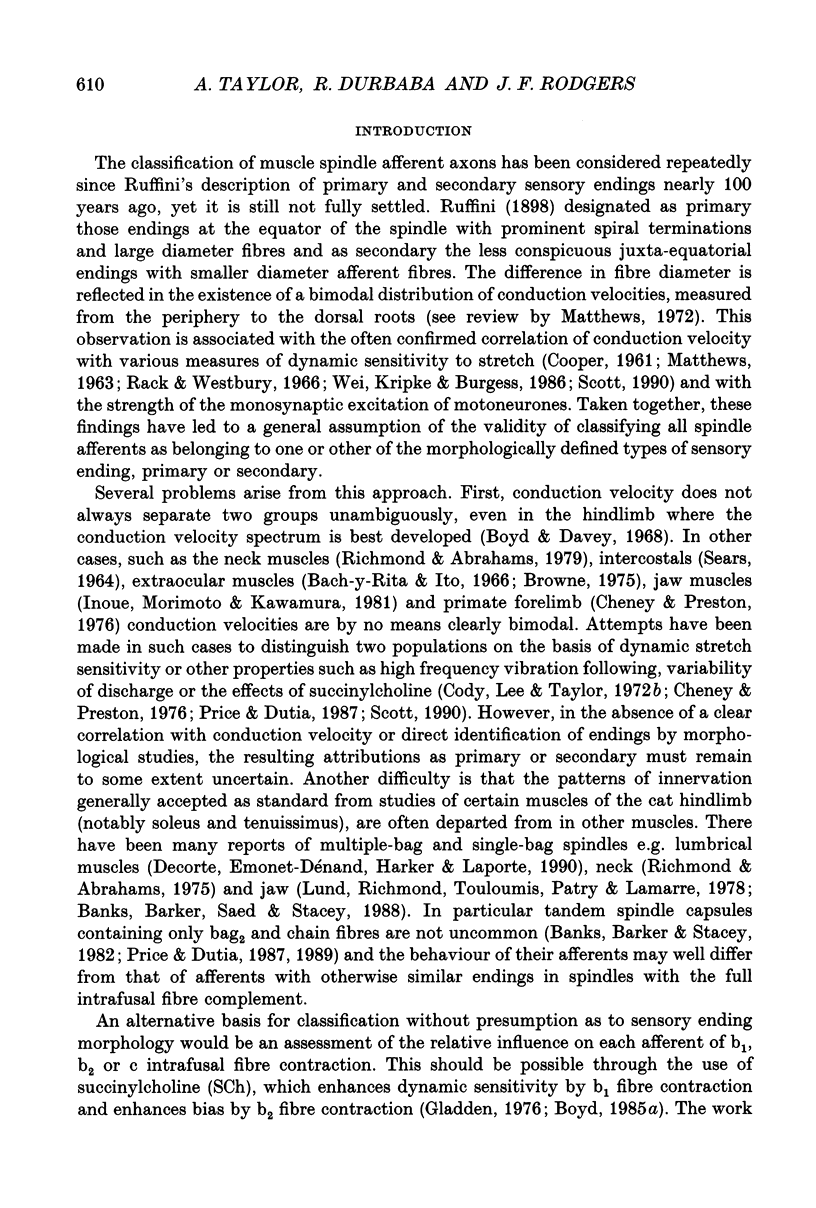
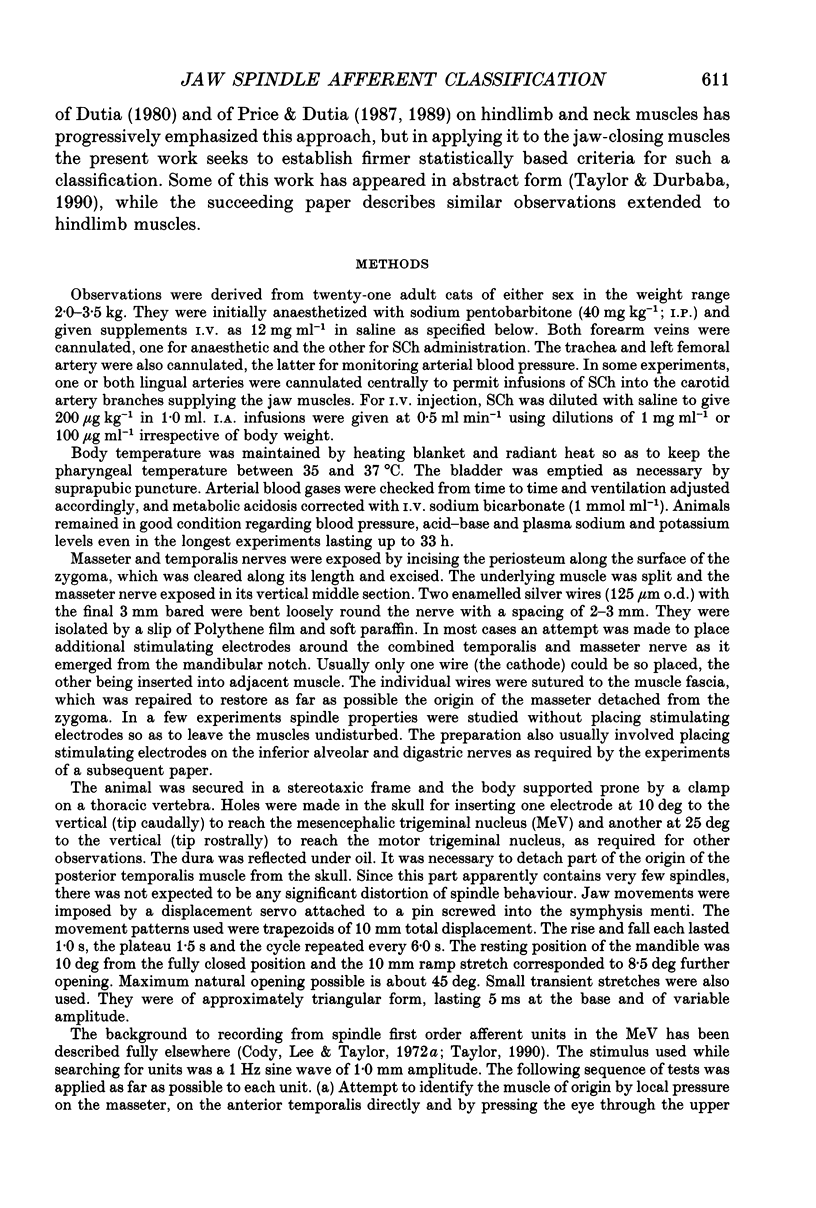

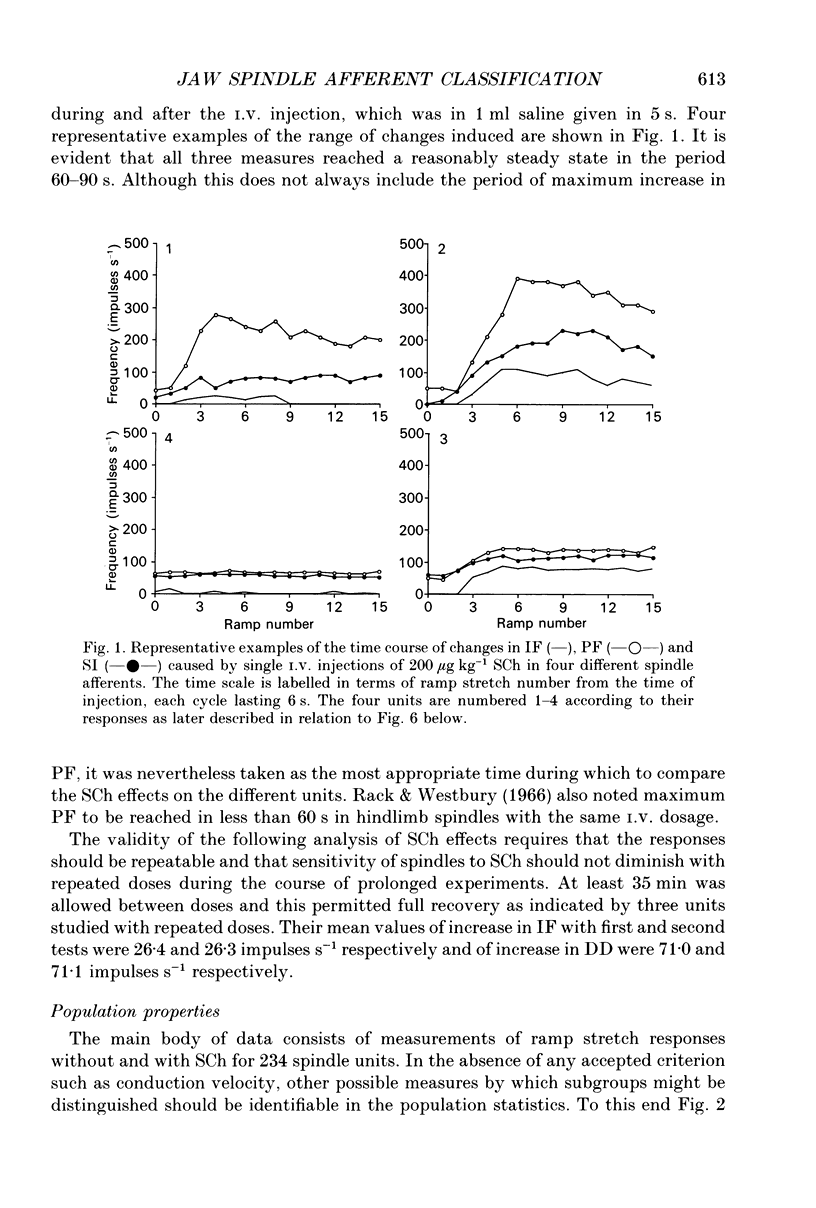
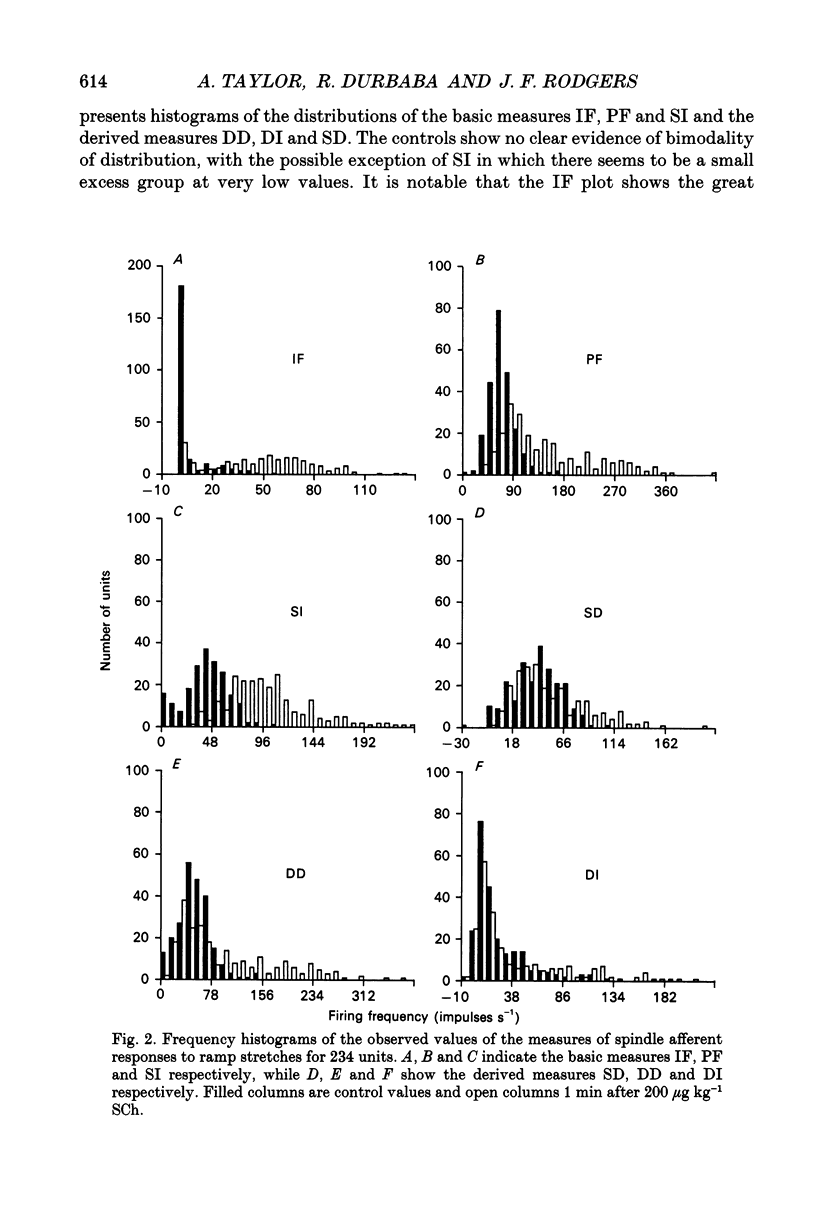
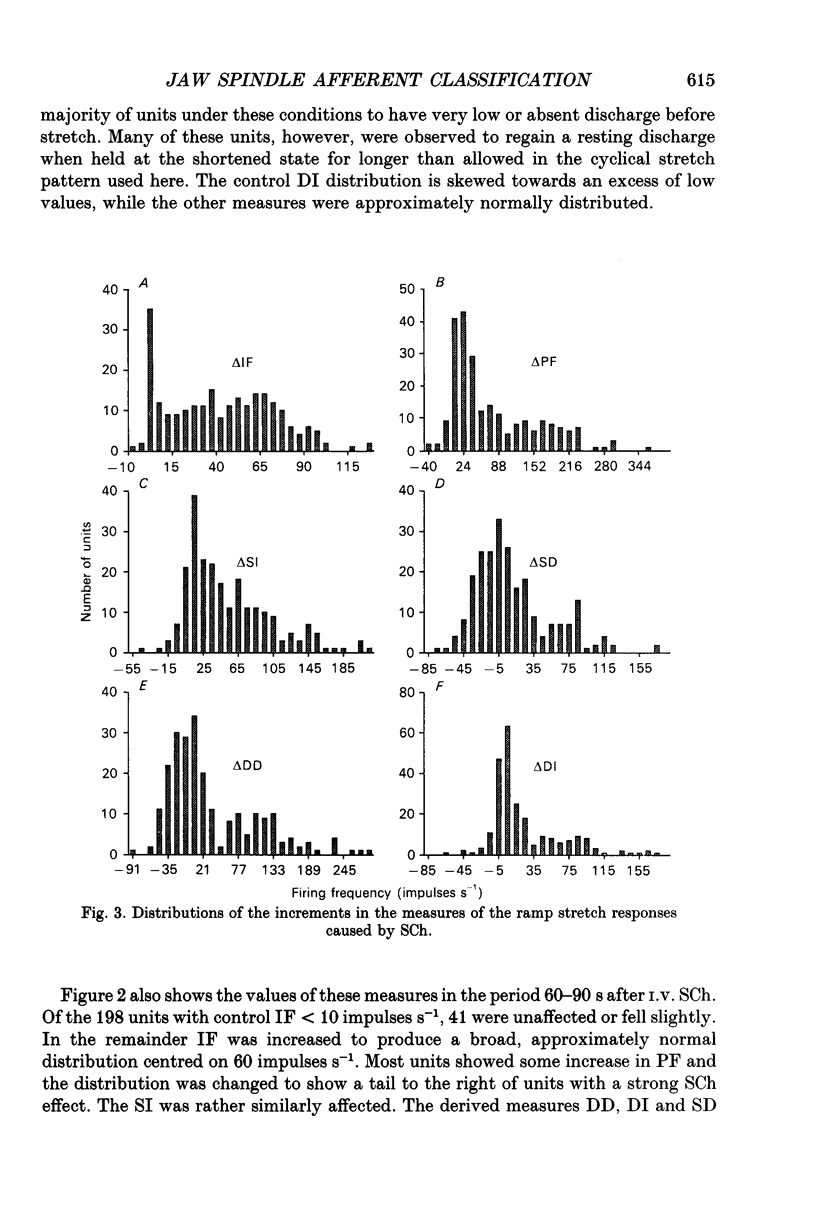

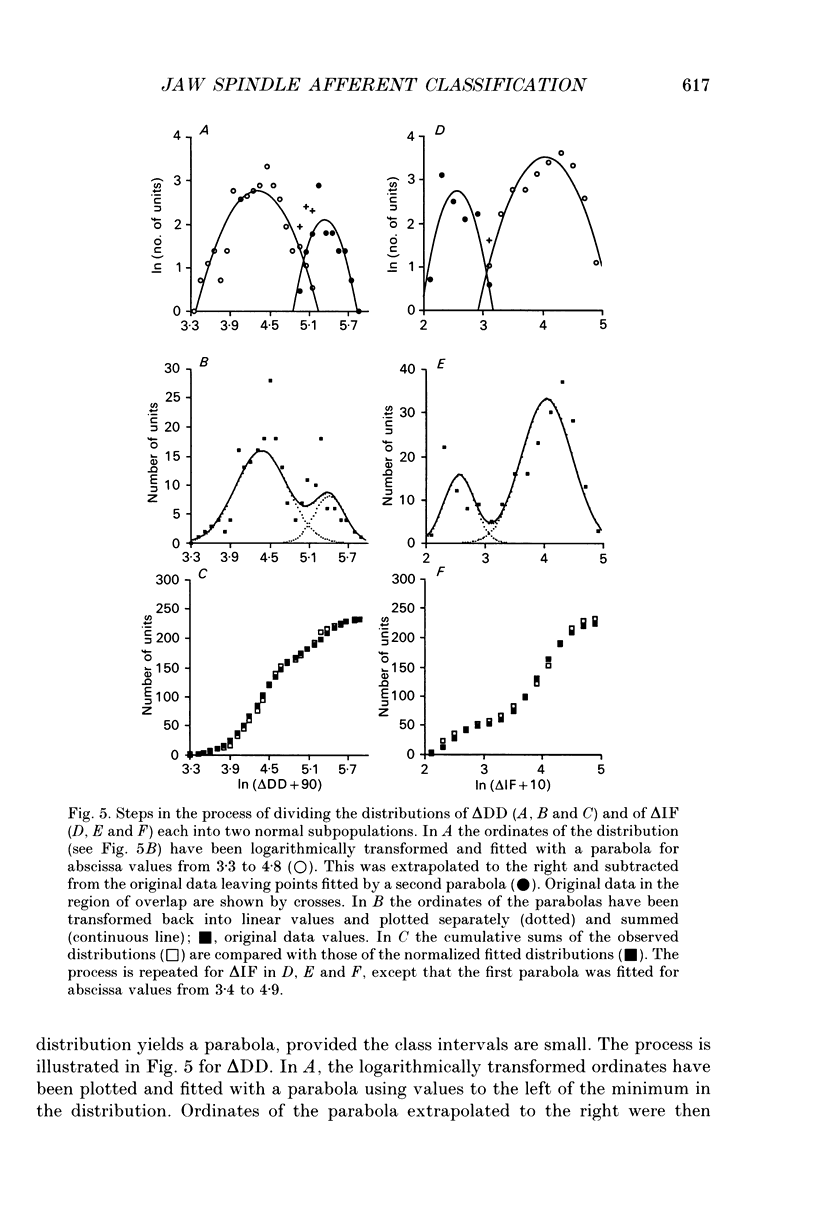
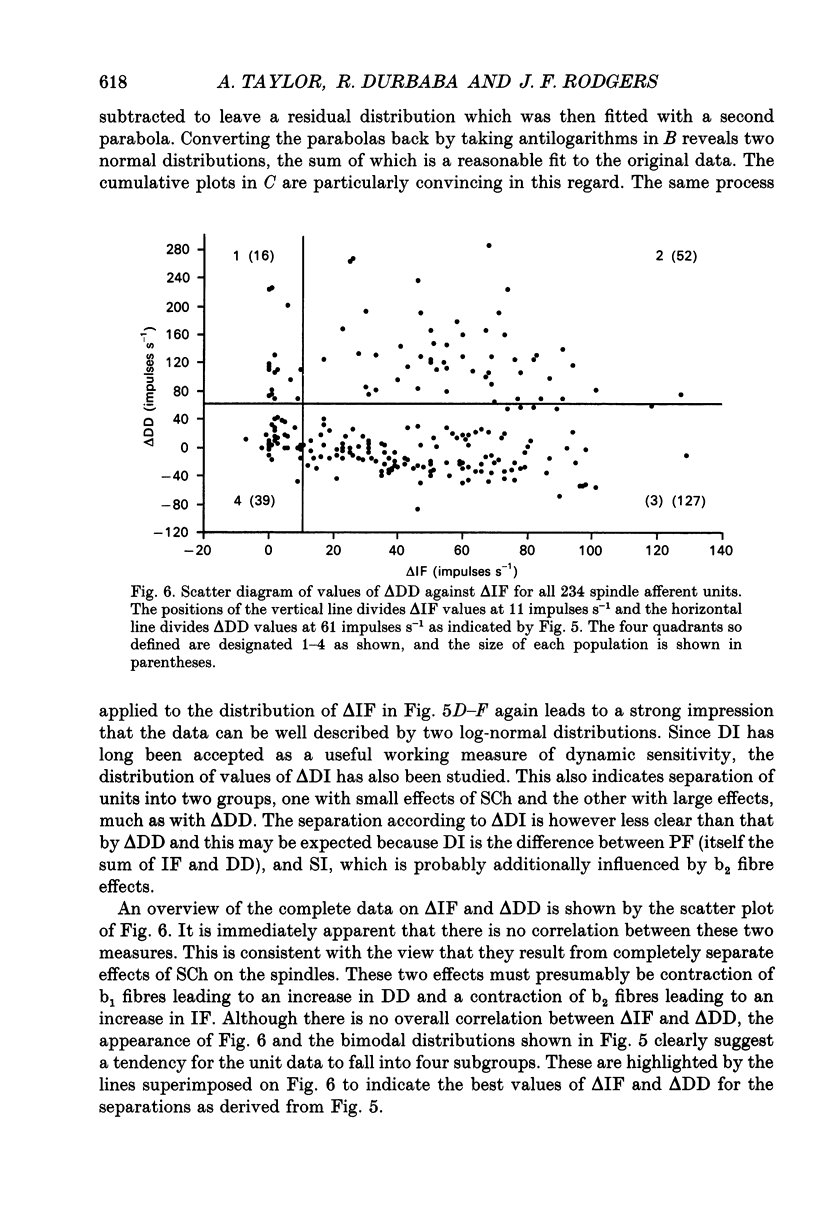

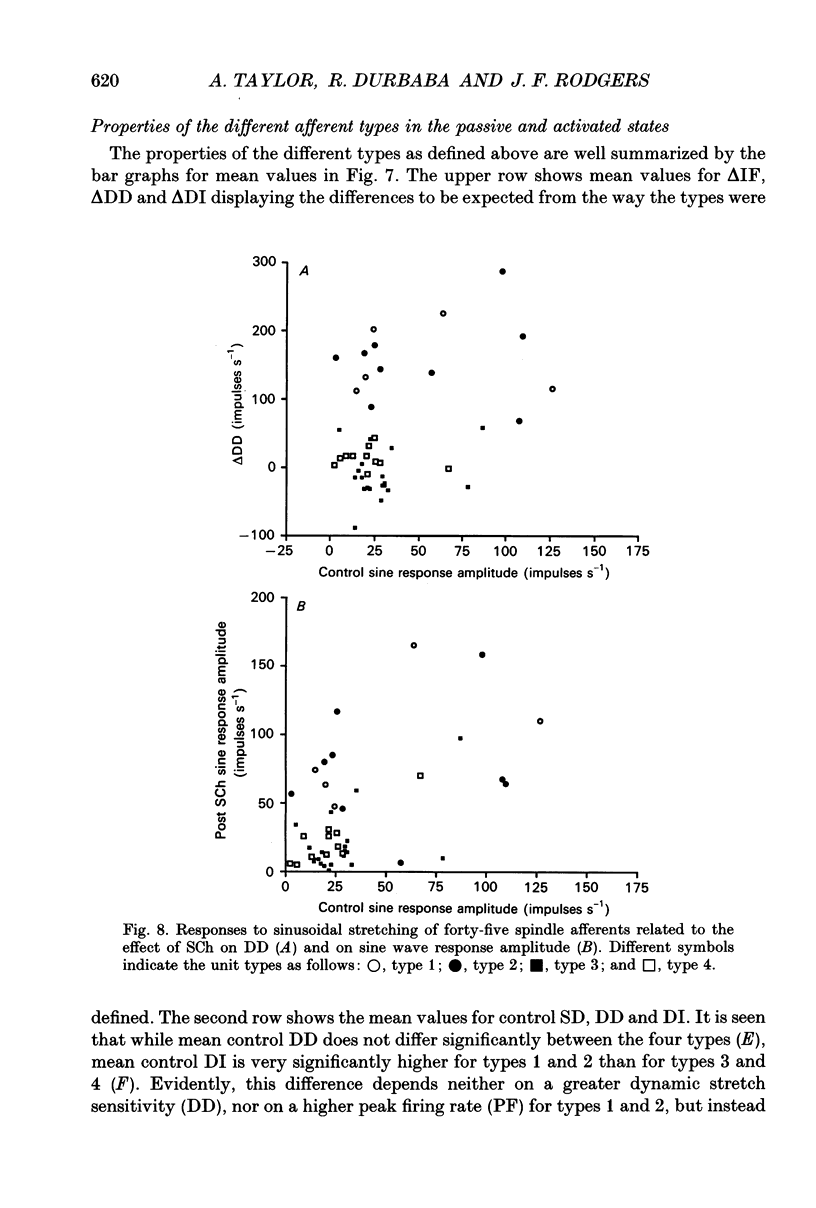
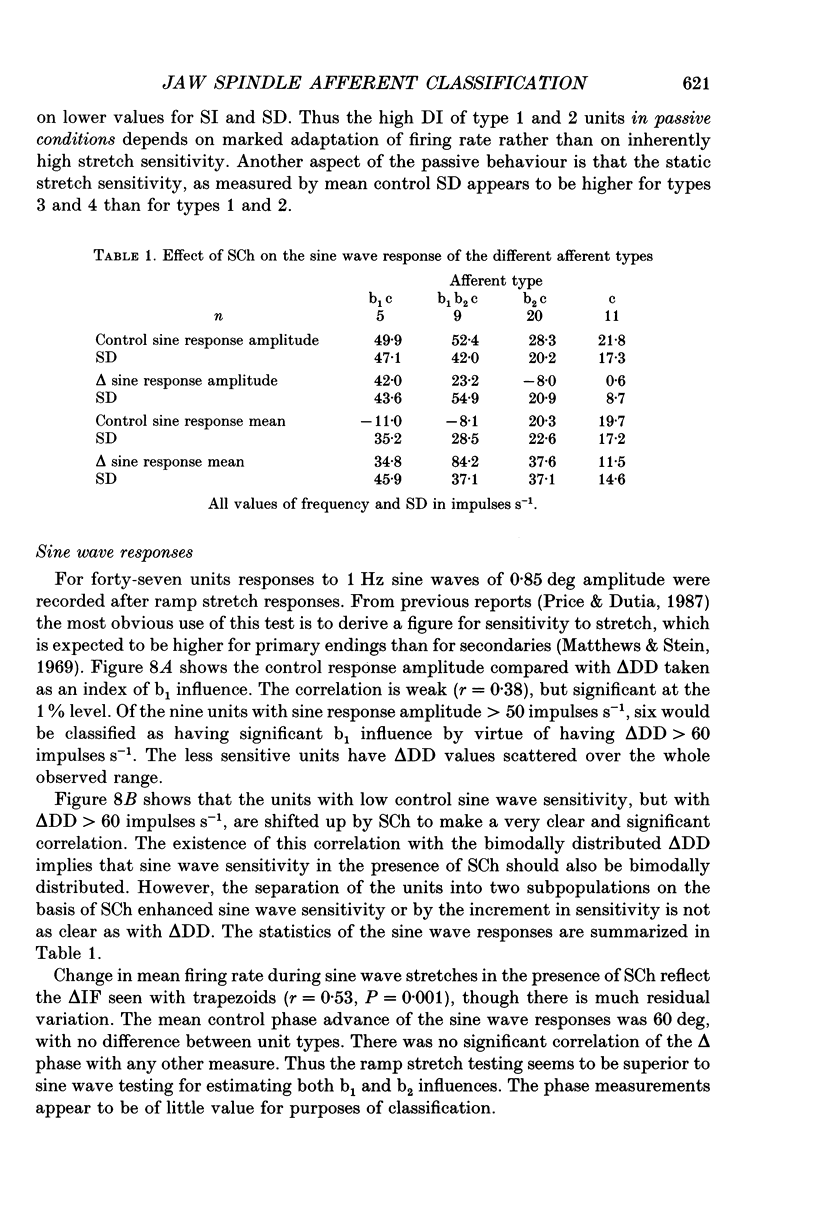

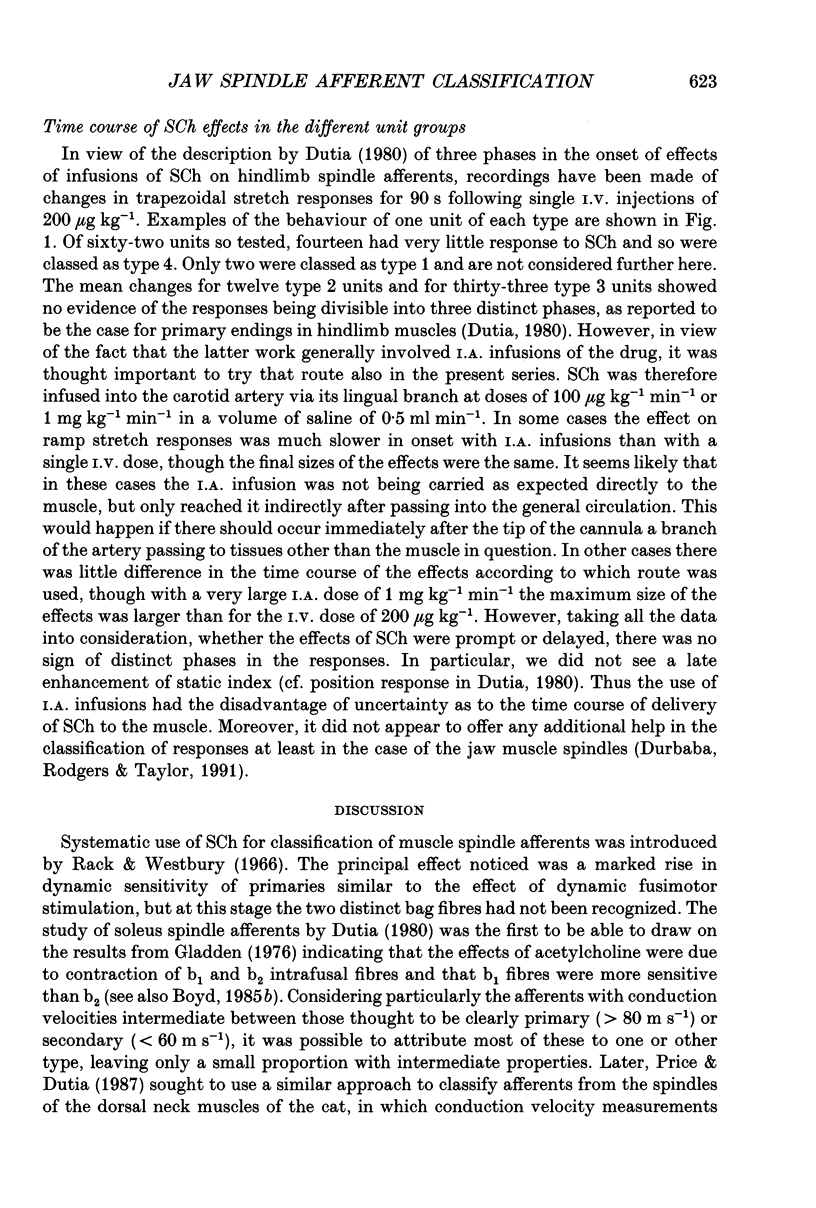
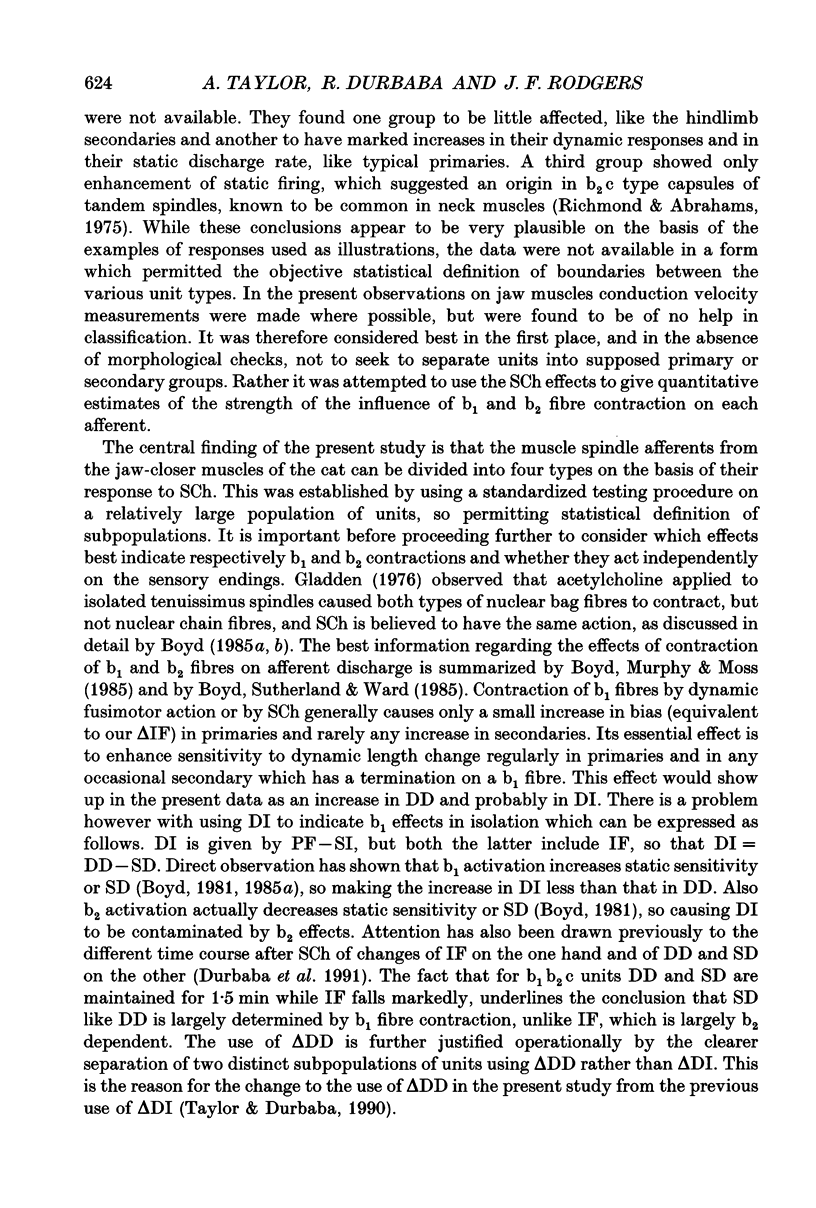
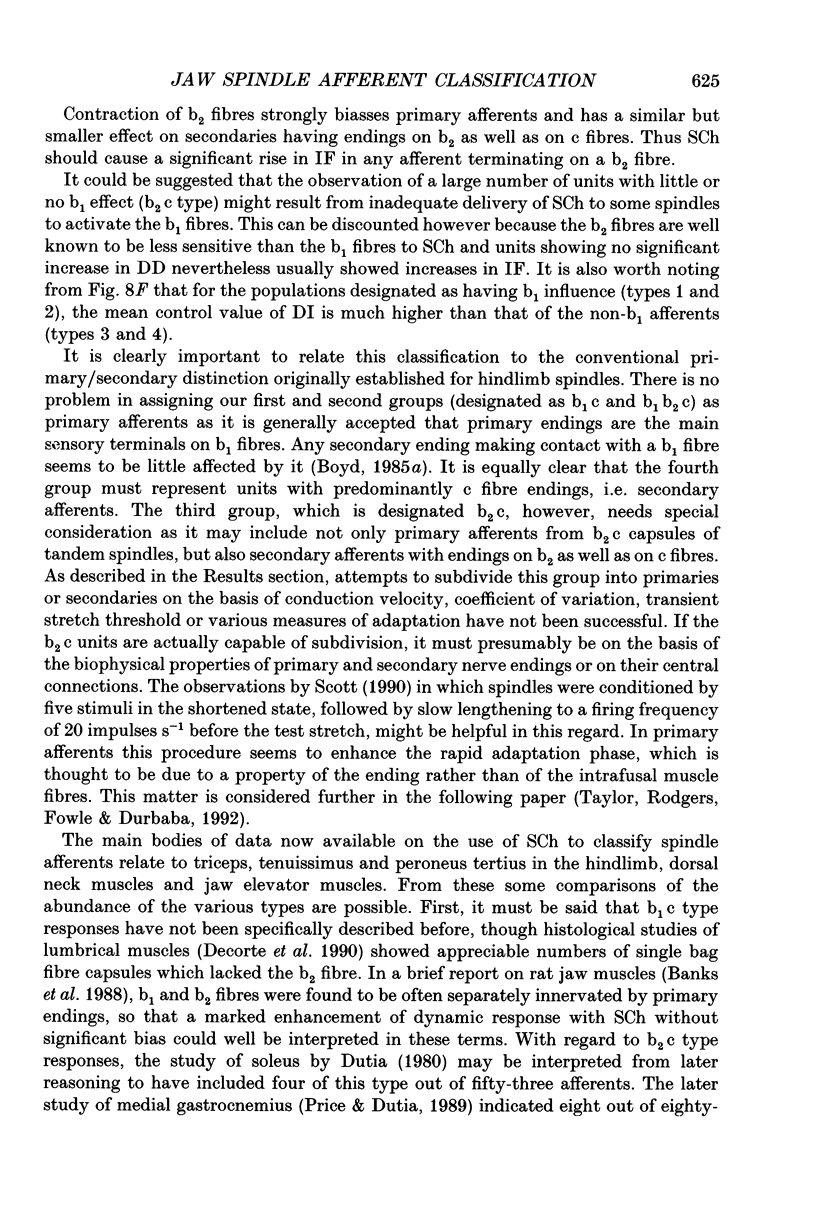

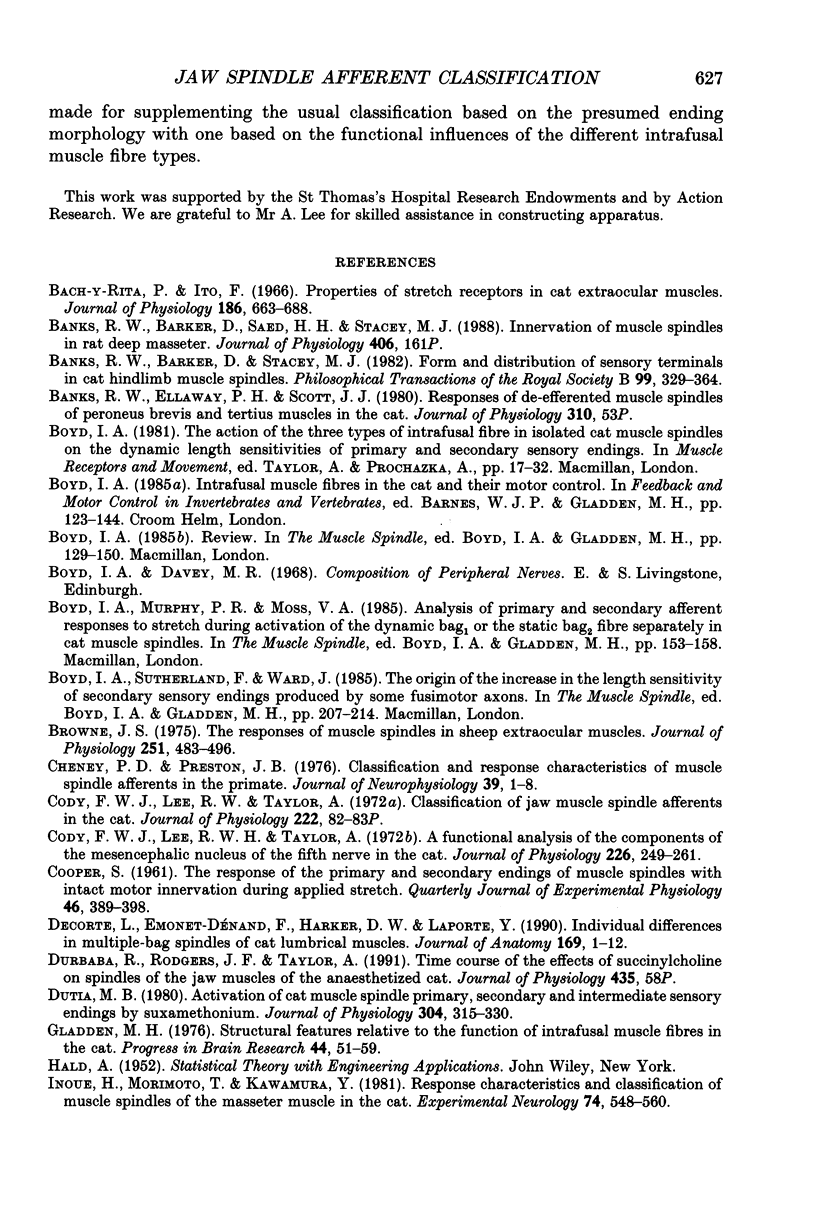

Images in this article
Selected References
These references are in PubMed. This may not be the complete list of references from this article.
- Bach-Y-Rita P., Ito F. Properties of stretch receptors in cat extraocular muscles. J Physiol. 1966 Oct;186(3):663–688. doi: 10.1113/jphysiol.1966.sp008061. [DOI] [PMC free article] [PubMed] [Google Scholar]
- Banks R. W., Barker D., Stacey M. J. Form and distribution of sensory terminals in cat hindlimb muscle spindles. Philos Trans R Soc Lond B Biol Sci. 1982 Nov 4;299(1096):329–364. doi: 10.1098/rstb.1982.0136. [DOI] [PubMed] [Google Scholar]
- Browne J. S. The responses of muscle spindles in sheep extraocular muscles. J Physiol. 1975 Oct;251(2):483–496. doi: 10.1113/jphysiol.1975.sp011104. [DOI] [PMC free article] [PubMed] [Google Scholar]
- COOPER S. The responses of the primary and secondary endings of muscle spindles with intact motor innervation during applied stretch. Q J Exp Physiol Cogn Med Sci. 1961 Oct;46:389–398. doi: 10.1113/expphysiol.1961.sp001558. [DOI] [PubMed] [Google Scholar]
- Cheney P. D., Preston J. B. Classification and response characteristics of muscle spindle afferents in the primate. J Neurophysiol. 1976 Jan;39(1):1–8. doi: 10.1152/jn.1976.39.1.1. [DOI] [PubMed] [Google Scholar]
- Cody F. W., Lee R. W., Taylor A. A functional analysis of the components of the mesencephalic nucleus of the fifth nerve in the cat. J Physiol. 1972 Oct;226(1):249–261. doi: 10.1113/jphysiol.1972.sp009983. [DOI] [PMC free article] [PubMed] [Google Scholar]
- Cody F. W., Lee R. W., Taylor A. Classification of jaw muscle spindle afferents in the cat. J Physiol. 1972 Apr;222(1):82P–83P. [PubMed] [Google Scholar]
- Decorte L., Emonet-Dénand F., Harker D. W., Laporte Y. Individual differences in multiple-bag spindles of cat superficial lumbrical muscles. J Anat. 1990 Apr;169:1–12. [PMC free article] [PubMed] [Google Scholar]
- Dutia M. B. Activation of cat muscle spindle primary, secondary and intermediate sensory endings by suxamethonium. J Physiol. 1980 Jul;304:315–330. doi: 10.1113/jphysiol.1980.sp013326. [DOI] [PMC free article] [PubMed] [Google Scholar]
- Gladden M. H. Structural features relative to the function of intrafusal muscle fibres in the cat. Prog Brain Res. 1976;44:51–59. doi: 10.1016/S0079-6123(08)60722-0. [DOI] [PubMed] [Google Scholar]
- Inoue H., Morimoto T., Kawamura Y. Response characteristics an classification of muscle spindles of the masseter muscle in the cat. Exp Neurol. 1981 Nov;74(2):548–560. doi: 10.1016/0014-4886(81)90190-4. [DOI] [PubMed] [Google Scholar]
- Lund J. P., Richmond F. J., Touloumis C., Patry Y., Lamarre Y. The distribution of Golgi tendon organs and muscle spindles in masseter and temporalis muscles of the cat. Neuroscience. 1978;3(2):259–270. doi: 10.1016/0306-4522(78)90107-0. [DOI] [PubMed] [Google Scholar]
- MATTHEWS P. B. THE RESPONSE OF DE-EFFERENTED MUSCLE SPINDLE RECEPTORS TO STRETCHING AT DIFFERENT VELOCITIES. J Physiol. 1963 Oct;168:660–678. doi: 10.1113/jphysiol.1963.sp007214. [DOI] [PMC free article] [PubMed] [Google Scholar]
- Matthews P. B., Stein R. B. The sensitivity of muscle spindle afferents to small sinusoidal changes of length. J Physiol. 1969 Feb;200(3):723–743. doi: 10.1113/jphysiol.1969.sp008719. [DOI] [PMC free article] [PubMed] [Google Scholar]
- Price R. F., Dutia M. B. Physiological properties of tandem muscle spindles in neck and hind-limb muscles. Prog Brain Res. 1989;80:47–7. doi: 10.1016/s0079-6123(08)62198-6. [DOI] [PubMed] [Google Scholar]
- Price R. F., Dutia M. B. Properties of cat neck muscle spindles and their excitation by succinylcholine. Exp Brain Res. 1987;68(3):619–630. doi: 10.1007/BF00249805. [DOI] [PubMed] [Google Scholar]
- Rack P. M., Westbury D. R. The effects of suxamethonium and acetylcholine on the behaviour of cat muscle spindles during dynamics stretching, and during fusimotor stimulation. J Physiol. 1966 Oct;186(3):698–713. doi: 10.1113/jphysiol.1966.sp008063. [DOI] [PMC free article] [PubMed] [Google Scholar]
- Richmond F. J., Abrahams V. C. Morphology and distribution of muscle spindles in dorsal muscles of the cat neck. J Neurophysiol. 1975 Nov;38(6):1322–1339. doi: 10.1152/jn.1975.38.6.1322. [DOI] [PubMed] [Google Scholar]
- Richmond F. J., Abrahams V. C. Physiological properties of muscle spindles in dorsal neck muscles of the cat. J Neurophysiol. 1979 Mar;42(2):604–617. doi: 10.1152/jn.1979.42.2.604. [DOI] [PubMed] [Google Scholar]
- Richmond F. J., Anstee G. C., Sherwin E. A., Abrahams V. C. Motor and sensory fibres of neck muscle nerves in the cat. Can J Physiol Pharmacol. 1976 Jun;54(3):294–304. doi: 10.1139/y76-043. [DOI] [PubMed] [Google Scholar]
- Richmond F. J., Bakker G. J., Bakker D. A., Stacey M. J. The innervation of tandem muscle spindles in the cat neck. J Comp Neurol. 1986 Mar 22;245(4):483–497. doi: 10.1002/cne.902450405. [DOI] [PubMed] [Google Scholar]
- Rowlerson A., Mascarello F., Barker D., Saed H. Muscle-spindle distribution in relation to the fibre-type composition of masseter in mammals. J Anat. 1988 Dec;161:37–60. [PMC free article] [PubMed] [Google Scholar]
- Ruffini A. On the Minute Anatomy of the Neuromuscular Spindles of the Cat, and on their Physiological Significance. J Physiol. 1898 Jul 26;23(3):190–208.3. doi: 10.1113/jphysiol.1898.sp000723. [DOI] [PMC free article] [PubMed] [Google Scholar]
- SEARS T. A. EFFERENT DISCHARGES IN ALPHA AND FUSIMOTOR FIBRES OF INTERCOSTAL NERVES OF THE CAT. J Physiol. 1964 Nov;174:295–315. doi: 10.1113/jphysiol.1964.sp007488. [DOI] [PMC free article] [PubMed] [Google Scholar]
- Scott J. J. Classification of muscle spindle afferents in the peroneus brevis muscle of the cat. Brain Res. 1990 Feb 12;509(1):62–70. doi: 10.1016/0006-8993(90)90309-y. [DOI] [PubMed] [Google Scholar]
- Scott J. J. Responses of Ia afferent axons from muscle spindles lacking a bag1 intrafusal muscle fibre. Brain Res. 1991 Mar 8;543(1):97–101. doi: 10.1016/0006-8993(91)91052-3. [DOI] [PubMed] [Google Scholar]
- Stein R. B., Mattews P. B. Differences in variability of discharge frequency between primary and secondary muscle spindle afferent endings of the cat. Nature. 1965 Dec 18;208(5016):1217–1218. doi: 10.1038/2081217a0. [DOI] [PubMed] [Google Scholar]
- Taylor A., Rodgers J. F., Fowle A. J., Durbaba R. The effect of succinylcholine on cat gastrocnemius muscle spindle afferents of different types. J Physiol. 1992 Oct;456:629–644. doi: 10.1113/jphysiol.1992.sp019357. [DOI] [PMC free article] [PubMed] [Google Scholar]
- Wei J. Y., Kripke B. R., Burgess P. R. Classification of muscle spindle receptors. Brain Res. 1986 Apr 2;370(1):119–126. doi: 10.1016/0006-8993(86)91111-x. [DOI] [PubMed] [Google Scholar]





